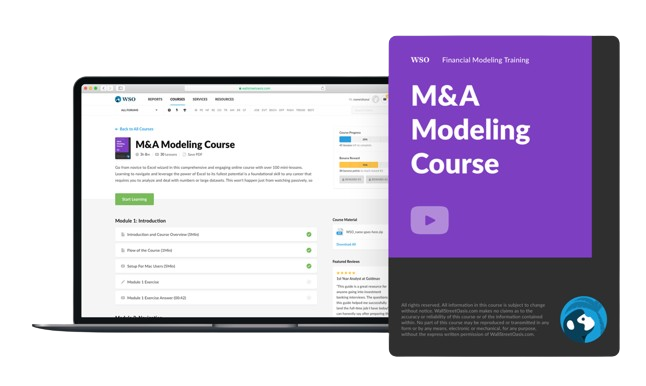Types of Synergies
Increased value created by a transaction, such as an Mergers and Acquisitions (M&A) deal that would not have not been created without the transaction
What Are The Types Of Synergies?
Synergy results from the increased value created by a transaction, such as an M&A (Mergers and Acquisitions) deal. Synergies are created when an M&A transaction generates value higher than the value of the two firms separately. An equation to represent this concept is 1 + 1 > 2.
For example, Company X is worth $400 million, and Company Y is worth $150 million independently. However, when Company X and Company Y combine through an M&A transaction, they are worth $650 million. In this case, there is a synergy of $100 million.
Now, you may be wondering what Mergers & Acquisitions are?
Mergers and acquisitions consolidate companies or their assets through certain financial transactions. Additions occur when one firm takes over another by purchasing it. Unions exist when two firms join together and operate as one entity.
A firm must understand the different types of synergies and their effects to optimize their M&A deals.
Key Takeaways
- Synergy occurs when the value created by an M&A deal is higher than the combined value of the two firms separately, represented as 1 + 1 > 2.
- M&A consolidates companies through financial transactions (additions and unions).
- Different types of synergies include cost synergies (reduced operating costs), revenue synergies (increased sales together), financial synergies (improved financial activities), marketing synergies (combined marketing efforts), and management synergies (benefits from reorganization).
- Synergies are recorded on the goodwill account and balance sheet.
- M&A transactions may fail to realize synergies due to miscalculations, culture clashes, and poor integration processes. Calculating the present value of synergies can be done using multiples or a Discounted Cash Flow (DCF) method.
Cost Synergies
Cost synergies occur when combined companies reduce their operating costs after merging. This results from increased efficiencies and lowered expenses (like equipment, insurance, and physical space).
Let's take a deeper look into the different ways in which merged companies can save on operating costs:
- Layoff of staff: Mergers sometimes result in less demand for some of the employees from each company.
- Proprietary technology: When one of the companies in the merger has proprietary technology, it benefits the other company. Technology that increases efficiency results in cost savings.
- Supply chain: If one company has superior supply chain operations, it, in turn, benefits the other company of the merger. Additionally, larger companies (typically the result of a merger) often have better bargaining power with suppliers, lowering their input costs.
- Research and development: One company in the merger can benefit from the other company's production of efficiency-increasing components. Only one company has to create that component for both to reap the benefits.
Example of Cost Synergies: Nine Entertainment Co's acquisition of Fairfax resulted in $50 million in cost savings. The cost synergies resulted from reduced sales, media, IT, and corporate overhead costs.
Revenue Synergies
Revenue synergies arise when two combined companies can achieve more sales than the sum of their sales individually. As a result, the new firm generates higher revenue than the two firms would have been able to accomplish on their own.
For example, Company X had revenue of $45 million, and Company B had revenue of $30 million. After merging, they have a combined income of $110 million. In this situation, there are revenue synergies of $35 million.
Sometimes revenue synergies occur because the combined firm now has access to a more significant number of products to be sold. It can also happen because the new firm now has more sales representatives and may not have to spend as much on marketing and distribution.
In comparison with cost synergies:
- Cost synergies are typically considered easier to calculate than revenue synergies because the cost structures of both companies are already established. Because of this, cost synergies are more likely to be created, so they are usually more reliable than revenue synergies.
- Estimating revenue synergies can be intricate because analysts must look into the future to predict the outcome of M&A transactions. Hence, the calculation of revenue synergies is intrinsically speculative.
- That said, synergies are difficult to achieve, regardless of the type. Therefore, it is advisable to estimate synergies conservatively not to overvalue a potential M&A transaction.
Example of Revenue Synergies
Facebook's Acquisition of Instagram: In 2012, Facebook acquired Instagram for $1 billion.
Now, Instagram was generating zero revenue. However, Facebook recognized revenue opportunities and synergies through this acquisition. As of December 2021, Instagram is now valued at $100 billion.
Financial Synergies
Financial synergies occur when a company's financial activities and conditions improve as a result of an M&A transaction. As opposed to operating synergies (e.g., cost and revenue), financial synergies primarily occur due to a reduction in the cost of capital.
A Few Examples of Financial Synergies:
1. Lower cost of capital
- The lower cost of capital is a result of the reduced cost of equity of a diversified merger. When mergers acquire an increased customer base and reduced competition, they can enjoy additional revenue, cash flow, and market share.
- All of this decreases their cost of equity and thus their cost of capital.
2. Tax benefits
- A merger can take advantage of tax laws by utilizing net operating losses as an income shield.
- For example, when a profit-making firm acquires an unprofitable firm, the new company can lower its tax burden by applying the net operating losses of the loss-making firm.
3. Increased debt capacity
- A merger can increase stability between the two firms' cash flows and earnings. Larger, merged firms typically receive more debt from lenders because they face lower loan interest rates than smaller firms.
Analysts typically use financial synergy to evaluate companies during M&A transactions. This is because financial synergies represent the growth of a firm's financial performance when two companies combine.
Marketing Synergy
Marketing synergies arise in the form of research and development, marketing tools, marketing staff, and information campaigns when two companies combine. With marketing synergies, the newly formed company can enjoy new marketing benefits for its product or service.
Achieving marketing synergy can be particularly useful for small businesses, which often do not have large budgets for marketing. Meaning, small businesses can benefit from marketing synergies by utilizing multiple, inexpensive initiatives.
Small businesses with low marketing budgets must depend on free or low-cost campaigns to achieve marketing synergy. The lowest-cost (sometimes free) methods include word-of-mouth and social media marketing.
Marketing synergy can be realized when companies can give their customers multiple, differing impressions of their brand. For example:
- Impressions through print
- Social media
- Word-of-mouth
All of which are necessary for growing a company's customer base.
When customers receive information about a company through different messaging pathways, the brand has greater influence, and they are more likely to engage with the brand.
As a result of the multiple marketing channels achieved by synergies, hopefully, the company will be able to expand its customer base.
Marketing initiatives require a lot of trial and error, so merging two companies can significantly reduce the time and money that companies spend trying out different marketing strategies on their own.
Management Synergy
As a result of an M&A transaction, the management teams of the two companies rearrangements. This can sometimes be beneficial, and other times be detrimental to the newly combined firm.
Suppose the result is a new management team that works cooperatively. In that case, the company can enjoy management synergy in the form of increased staff motivation, improved service delivery, correct use of resources, and additional opportunities for business growth.
Also, management synergy can include reducing duplicate job positions and redundant levels of management.
At a more granular level, the reorganization of management can benefit a company through:
1. Diversity
Increased inclusion of additional staff with varying perspectives and backgrounds can greatly enhance a company.
2. Creativity
Access to a greater variation and staff will intrinsically increase the number of ideas flowing through the company.
3. Focus
Management synergy can help companies achieve an organizational vision and allow them to focus on their mission.
On the other hand, when the newly combined companies do not work in harmony, this can create new conflicts. As a result, the company's goods and services may decline in quality, there may be a reduction in operational efficiency, and there may be poor resource utilization.
How Do Companies Account for Synergies?
The newly combined company can account for the synergies achieved by an M&A transaction by recording it on its goodwill account and balance sheet. On the balance sheet, goodwill is recorded as a non-current asset.
Goodwill is the intangible asset that is gained with one company's acquisition of another company. It is calculated by subtracting the difference between the fair market value of the assets and liabilities from the company's purchase price.
For example, if a company has net assets of $725,000 and an investor agrees to pay $1 million for the company, there will be a goodwill value of $275,000 reflected on the balance sheet.
Goodwill represents the expected future value of a company's growth due to a merger or acquisition. Thus, the value of goodwill must account for the expected future cash flows, growth rates, revenues, and company capital costs.
Unfortunately, M&A synergies are not achieved 70% of the time. The combining of two companies is much earlier said than done. There are a few reasons why M&A transactions fail to realize synergies, some of which include:
- Miscalculation/Misvaluation: The acquiring company may overpay for a company, and as a result, it can never financially recover from the investment.
- Culture Clash: It is often difficult to combine different management teams of companies, especially when dealing with cross-border transactions.
- Poor Integration Process: Combining two companies' systems, processes, technologies, and employees is often very challenging.
How to Calculate Synergy
The present value of synergies can be calculated using multiples or a Discounted Cash Flow (DCF).
1) Multiple Method
A firm can use multiple earnings (like EV/EBIT) to represent the long-term growth rate of synergies.
Step 1: Calculate the Present Value of Synergies
| Step 1 | |
|---|---|
| Forward Year 1 SG&A Synergies (Pre-Tax) | 40 million |
| Target EV / FWY 1 EBIT | 6.5x |
| Present Value of Synergies | 260 million (40 x 6.5x) |
Notes:
- EV / FWY 1 EBIT
- This multiple represents the enterprise value (EV) ratio to the combined company's projected EBIT in year 1.
- SG&A savings of 40 million will increase the combined company's EV by 250 million.
Step 2: Apply the PV of Synergies
| Step 2 | |
|---|---|
| Acquisition Equity Value | 1,800 million |
| Pre-offer Market Capitalization | 1,600 million |
| Forward year 1 SG&A Synergies | 40 million |
| Marginal Tax Rate (MTR) | 25% |
| Target Weighted Average Cost of Capital (WACC) | 6% |
| Growth Rate in Synergies | 0% |
Control Premium Paid = Acquisition Equity Value - Pre-offer Market Capitalization
= 1,800 - 1,600
= 200 million
Step 3: Compare Control Premium Paid vs. PV of Synergies
| Step 3 | |
|---|---|
| Control Premium Paid | 200 million |
| PV of Synergies | 260 million |
| Value Created / Destroyed | 60 million |
Since the PV of Synergies is higher than the Control Premium Paid, the value created is 60 million.
2) DCF Method
In simple terms, a Discounted Cash Flow is a method of valuation used to calculate the value of an investment based on its expected future cash flows.
| DCF Method | |
|---|---|
| Forward Year 1 SG&A Synergies (Pre-Tax) | 40 million |
| MTR | 25% |
| Post-Tax Synergies | 30 million (40 x 0.75) |
| Discount Rate / Target WACC |
6 % |
| PV of Synergies | 500 million (30 / 0.06) |




or Want to Sign up with your social account?